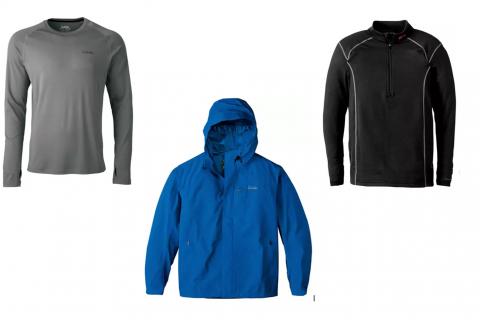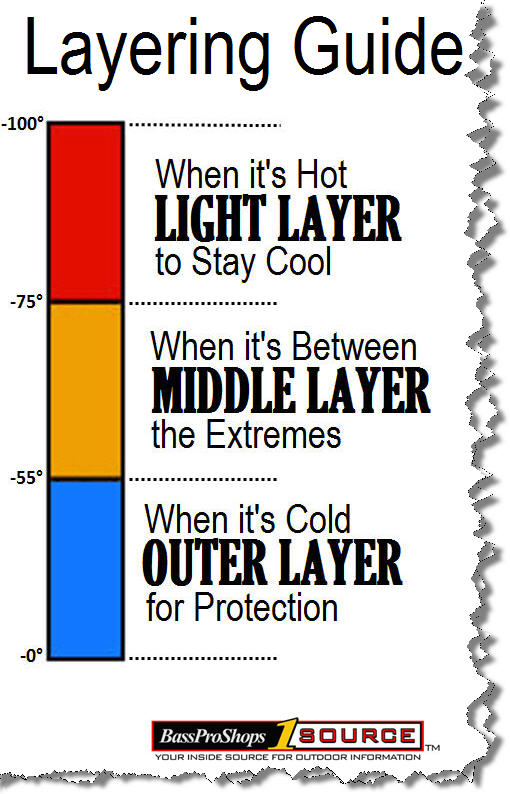
For many outdoor enthusiasts, the importance of dressing in layers is well known. This method of dressing allows you to regulate your temperature by peeling-off or putting-on clothing layers — clothes that together wick moisture, insulate and protect from wind and rain. Each year, outdoor clothing becomes more specialized and better designed to support a layered system. Let's review the art of layering for outdoor activities.
What and Why is Layering Clothing Important?
Layering is wearing a combination of clothes to regulate your body temperature, so you don't overheat or get cold. The system must match the climate conditions you are in, your activity level and your individual thermostat. Layers are broken into three categories: Inner, mid, and outer. These three layers act in unison (to trap heat, wick moisture, breathe, block wind, and repel water) but individually each layer performs specific functions.
Base Clothing Layer

Layer Crew for Men
The inner layer, also called a base layer, is the first layer of clothing you wear, directly contacting your skin. Long or short sleeve tops, full-length bottoms or briefs, and sock liners are examples of inner layers. A base layer should fit snug. This fit lets the material quickly wick away moisture from your skin keeping you dry and warm. Inner layer materials are often made of polyester, polypropylene, silk, or a mix of synthetic and natural insulating and wicking fibers, like polyester and wool. Inner layers are classified in three weight types.
Shop bass layers for men, shop base layers for ladies, shop base layers for kids.
Lightweight base layers are designed for intense aerobic activity (where moisture wicking is crucial to comfort) but provide little insulation. Midweight base layers provides moisture wicking properties as well as insulation for low intensity aerobic activities. A heavyweight base layer will wick moisture but is intended to insulate in cold conditions. It's important to anticipate the temperatures you'll be in and pick the appropriate weight for an inner layer.
Mid-Clothing Layer
The mid layer should be a looser fit than the inner layer, but not baggy. It needs to maintain contact with the inner layer to function properly. These materials are designed to trap and hold your body heat in small air spaces in the material; hence, why mid layers can feel lofty. Mids layers are also designed to carry moisture away from the inner layer, moving it from the body and pushing it to the outer layer. Mid layer materials range significantly, but some common ones are fleece, polyester, down and wool. Many manufactures produce patented synthetic and natural blended materials for mid weight layers as well.

Turtleneck with X-Odor for Men
Mid layers are not universally categorized in lights, mids or heavyweights, but you may see these terms occasionally used by some companies to describe the degrees of insulation their clothes provide. Depending on the temperatures you are in, you may need to wear more than one mid layer. For example, in cold conditions you may have a wool top and then a fleece jacket as well. That's the benefit of dressing in layers; you can add or remove clothing as you need to keep comfortable.
When buying mid layers, some extra features will increase your comfort. Under arm zippers allow for ventilation options to help regulate your temperature. Zip-up collars allow you to trap heat in cool conditions, providing warmth to your neck, but can be opened for releasing heat if you're too hot. Also, some heavy-fleece, mid layers will zip into an outer layer forming and two-layer jacket. (Note: you'll still want a snug fitting mid layer if you use a zip-in liner with a jacket. The liner won't fit snug enough against the inner layer to properly trap heat or wick moisture.)
Outer Clothing Layer

GORE-TEX PacLite for Men
Manufacturers do not define outer layers consistently. Some describe outer layers as a shell (i.e., wind and rain type jackets) to protect you from the elements, while being breathable so your internal moisture can escape. For this discussion, I'll use the definition just presented. In addition to the above description, some describe an outer layer as jackets and pants that provide insulation. As long as the units block wind or water they classify as an outer layer. If wind or rain can get through them, they are mid-layer clothes. These differences, although subtle, are important to know as a buyer.
When looking for a waterproof and windproof shell, you can't beat a Gore-Tex outer layer. If you don't anticipate wet conditions, a lighter outer layer may suit you fine. Clothing design can also aid in breathability. Zippers under arms help you air out when engaged in aerobic activities or when you're caught in the high humidity of a summer thunderstorm. Ankle zippers aid in putting-on or taking-off pants while wearing footwear, and also allow for a snug fit over boots.
The outer layer should also be rugged and able to stand up to abuse. If its material tears on a tree branch, you've just ruined not only a jacket, but also your layering system if it starts to rain! That said if you're just out on a walk on an autumn day, a nylon windbreaker-type shell might suffice.
Do I Always Need Three Clothing Layers?
 No. You'll always want to start with a non-cotton inner layer, though. Sometimes this layer and shorts may be all you need in hot temperatures or high aerobic activities. Mid layers provide the most flexibility, letting you adapt to most temperatures and activity levels. If there's no wind or rain, you might not need an outer layer — at that particular moment. Yet, the weather constantly changes, so it's better to have an outer shell you can store and retrieve it when needed. This is especially true on multi-day treks.
No. You'll always want to start with a non-cotton inner layer, though. Sometimes this layer and shorts may be all you need in hot temperatures or high aerobic activities. Mid layers provide the most flexibility, letting you adapt to most temperatures and activity levels. If there's no wind or rain, you might not need an outer layer — at that particular moment. Yet, the weather constantly changes, so it's better to have an outer shell you can store and retrieve it when needed. This is especially true on multi-day treks.
Say Good-bye to Cotton Clothing
Don't wear cotton clothing as part of a layering system. You might get by wearing a cotton T-shirt fishing in a boat on a mild summer day, or wearing cotton socks for some minor yard work, but once you get active cotton works against you. Cotton's inherent properties cause it to trap moisture, as oppose to releasing it. When damp cotton is against your body it draws heat from you. Also, if you're wearing damp cotton socks or underwear it can cause discomfort and chafing. Do yourself a favor and replace the cotton clothes you have for sport activities with new synthetic ones.
Keep Clothing Layers Clean
It's important to read the washing and care instructions on your outdoor clothing. Synthetic materials often need to be clean to properly wick moisture, insulate and repel rain. Many products discourage the use of dry cleaning or fabric softeners, but some synthetic fabrics need the heat of a dryer to reinstate their moisture wicking and insulating properties. Cleaning solutions are also available to help restore these two properties as well.
For outerwear, a good rule of thumb is that if water isn't beading on the fabric, you need to wash your gear. Check the washing instructions. Most encourage hand washing, hanging products to dry or using a low heat drier setting, and some suggest ironing to renew water repellency. If required you may occasionally need to treat your outer shell with a spray-on solution to restore its repellency.
Clothing for Head, Hads and Feet

Work Gloves for Men
You could have the best layering system in the world, but if you don't keep your extremities protected, you'll be uncomfortable. It's important to match hats, mitts, socks and footwear to the climate and your activity level, but also to your own personal nuances. For example, when fishing in cold temperatures my feet are always the first to get cold, so I make sure I keep them dry and wear proper socks. Blocking the wind is also important for hats and mitts. Fleece models can be extremely warm on cool days, but a wind can easily blow through them carrying away your body heat. In this case wear an outer liner, or invest in ones with a wind-blocking layer that's laminated on the inside.
Clothing Layer Tips
- Don't let yourself overheat when outdoors. Peel off layers as needed to regulate your temperature when active, and add layers when not generating enough heat.
- Err on having too many layers. It's better to be prepared and flexible, than to be underdressed and exposed to cold-related risks.
- If you're active and then plan to be stationary for a long time (such as walking to an ice fishing spot), consider bringing an extra inner layer and changing into this new one after the activity. It's tough to change in cold temperatures but the dry clothes will do wonders for your comfort.
- Don't forget to stay hydrated when outdoors. The effects of dehydration will counter act the effectiveness of your layering system and your body's ability to keep you warm.
Proper layering is one of the most fundamental concepts in outdoor recreation. Learn how to layer and you'll be more comfortable outdoors. Stay away from cotton, focus on using the three layers where appropriate, and remove layers to prevent overheating or add them to stay warm. Follow these basic rules, and you'll get a lot more enjoyment from your time outdoors.
- 31561 views

